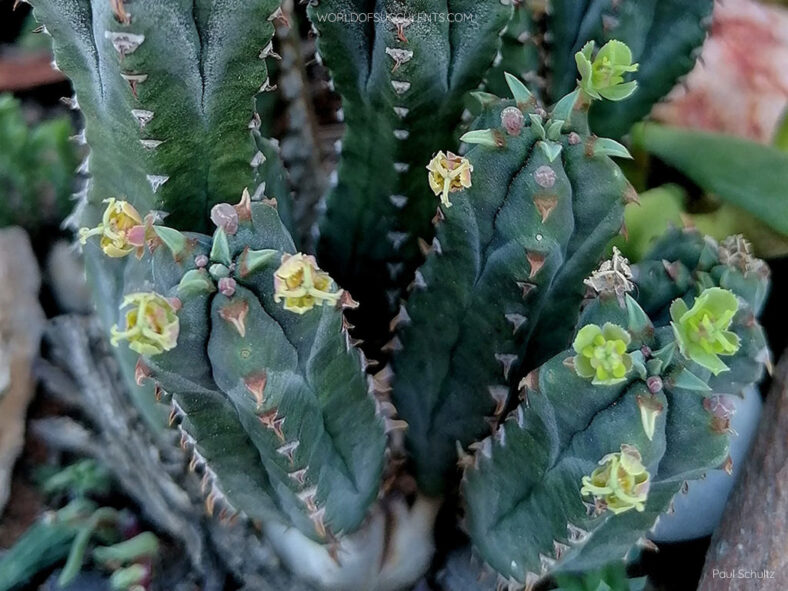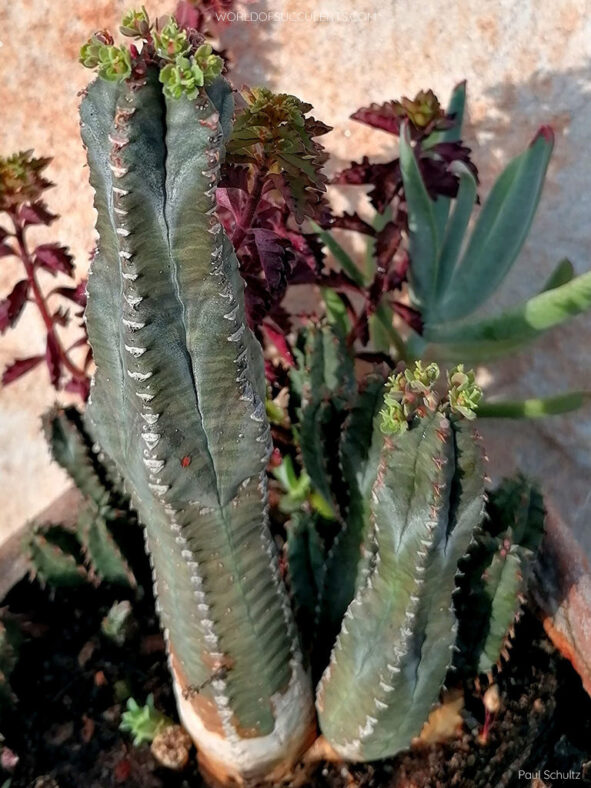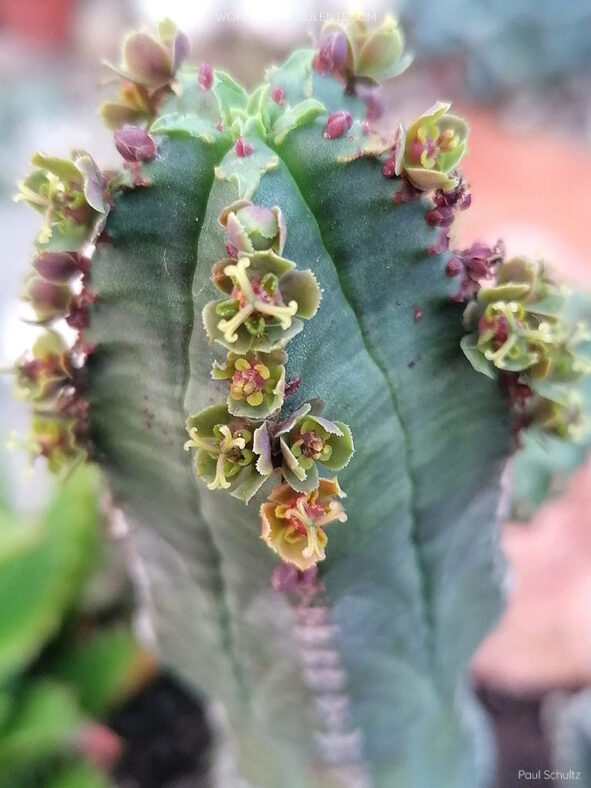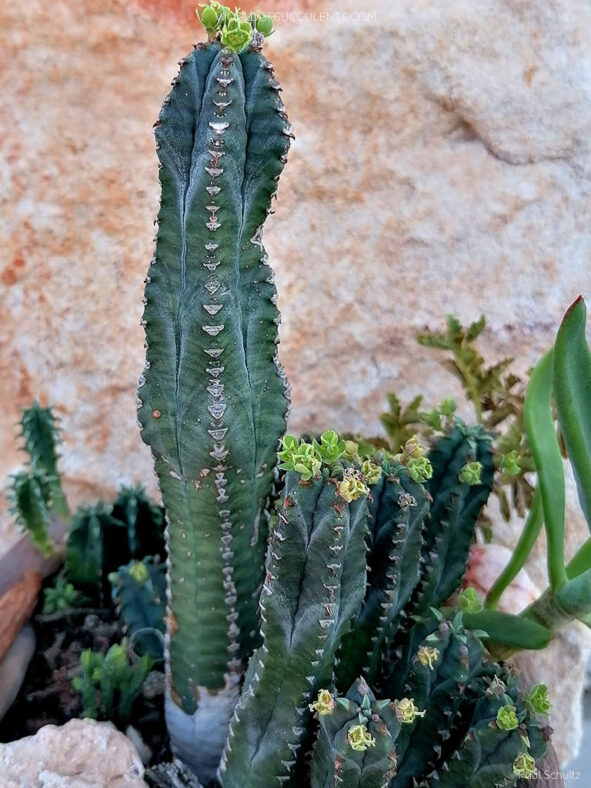Due to its unique characteristics, Euphorbia jansenvillensis was previously recognized as a separate species. However, recent taxonomic studies have shown that the differences between Euphorbia jansenvillensis and Euphorbia tubiglans are not significant enough to classify them as separate species. As a result, Euphorbia jansenvillensis is now treated as a synonym of the older, validly published name Euphorbia tubiglans.
Euphorbia jansenvillensis has longer stems compared to Euphorbia tubiglans. Additionally, its involucral glands are yellowish-green, distant, erect, and folded in the shape of an inverted cone, whereas those of Euphorbia tubiglans are red, distant, and folded into a tube.
Scientific Name
Euphorbia jansenvillensis Nel
Scientific Name
Euphorbia tubiglans Marloth ex R.A.Dyer
Synonym(s)
Euphorbia tubiglans var. jansenvillensis
Scientific Classification
Family: Euphorbiaceae
Subfamily: Euphorbioideae
Tribe: Euphorbieae
Subtribe: Euphorbiinae
Genus: Euphorbia
Etymology
The specific epithet "jansenvillensis" (pronounced "jan-sen-vil-EN-sis") means "of or from Jansenville" and refers to Jansenville, a town in the Sarah Baartman District Municipality in the Eastern Cape province of South Africa, where the unique type specimen of this plant was collected.
Origin
Euphorbia jansenvillensis is native to South Africa. It grows wedged among stones and in the shelter of low bushes from Steytlerville to Klipplaat and Jansenville.
Description
Euphorbia jansenvillensis is a small succulent with an underground stem and glaucous to dark green, upright branches with typically five ribs, although some may have four. It branches from the base, forming a dwarf shrub over time. The underground stem can reach a thickness of up to 2 inches (5 cm), while the branches can grow up to 12 inches (30 cm) long and 1.2 inches (3 cm) thick. The ribs are more prominent at the top than at the bottom, and they are lined with short, sharp podariae that lack spines. The leaf rudiments are linear or taper to a fine point, and they are only present very close to the tips of the branches.
From mid-spring to mid-fall, Euphorbia jansenvillensis produces solitary cyathia on short stalks that emerge from the ribs near the top of the branches. Each cyathium has five yellowish-green glands that fold into an inverted cone. The fruits are smooth, obtusely 3-angled capsules that can reach a diameter of 0.25 inch (0.6 cm).

How to Grow and Care for Euphorbia jansenvillensis
Light: Euphorbia jansenvillensis requires plenty of sunlight for optimal growth. During the warmer months, place it near a sunny window or move it to your balcony or garden, gradually increasing sun exposure to avoid sunburn.
Soil: Use a well-draining soil, either a commercial potting mix formulated for succulents or create your own well-draining soil.
Temperature: While high summer temperatures are not a problem, low winter temperatures can damage or kill your plant. Euphorbia jansenvillensis is hardy in USDA Plant Hardiness Zones 10a-11b, which have average annual extreme minimum winter temperatures ranging from 30°F to 50°F (-1.1°C to 10°C).
Watering: From spring to fall, water the plant when the top inch (2.5 cm) of the soil feels dry. Reduce watering in winter and give it just enough water to prevent wilting. During the warm season, the evening is the best time of day for watering.
Fertilizing: To ensure the potted plant receives sufficient nutrients, apply a balanced fertilizer in a 10-10-10 NPK formulation, diluted to 1/4 strength weekly during the growing season.
Repotting: Although your Euphorbia jansenvillensis does not need to be repotted often, it will benefit from repotting when it outgrows its pot. Repotting is best done in early spring, at the beginning of the growing season. When handling this plant, wear gloves, protective clothing, and appropriate eye protection.
Propagation: The easiest and fastest method to propagate this plant is by stem cuttings. While starting Euphorbia jansenvillensis from seeds is possible, germination can be challenging. Take cuttings only during the growing season. Spring is the ideal time to sow the seeds.
Learn more at How to Grow and Care for Euphorbia.
Toxicity of Euphorbia jansenvillensis
Euphorbia jansenvillensis produces a poisonous white milky sap that may cause burns or irritation if it comes into contact with the skin or eyes. Therefore, it is best to keep this plant out of the reach of children and pets.
Links
- Back to genus Euphorbia
- Succupedia: Browse succulents by Scientific Name, Common Name, Genus, Family, USDA Hardiness Zone, Origin, or cacti by Genus
Photo Gallery
Click on a photo to see a larger version.


